ILP Based Power-Aware Test Time Reduction Using On-Chip Clocking in NoC Based SoC
Abstract
1. Introduction
2. Prior Work
3. Motivation
4. Problem Statement
- Given the number of inputs, outputs and scan chains for the NoC based SoC;
- Given the maximum TAM width Wmax to be used for data transfer between IP cores of SoC;
- Given the network topology for NoC to be used for IP cores of SoC;
- Given the multiple test clock frequency for the testing of various IP Cores in NoC based SoC;
- Optimum allocation of the core to the input-output pairs.
- Optimum allocation of test clock to the cores.
- Scheduling algorithm to minimize test time with given power constraints.
5. Proposed Methodology
- Nc = Number of Cores;
- Np = Number of input-output pairs available in NoC based SoC;
- Wmax = a maximum TAM width;
- ti = test time of core i;
- fn = multiple test clock frequencies.
- T = total test time
- Tro = time consumed in the router
- Tchan = time consumed in NoC channels
- Nchan = number of channels
- Nro = the number of routers
- Pro = power consumed in the router
- Pchan = power consumed in NoC channels
- Nchan = number of channels
- Nro = number of routers
- Si = length of wrapper-scan-in chain
- So = length of wrapper-scan-out chain
- TP = Test pattern count of the core
6. Experimental Results and Analysis
- Single frequency allocation: where the normal test frequency is applied to each core and then test scheduling is done.
- Multiple frequency allocation: each core is mapped with any one of f/2, f, and 2f frequency and then power constrained test scheduling is done.
7. Conclusions
Author Contributions
Funding
Conflicts of Interest
References
- Moreno, E.; Webber, T.; Marcon, C.; Moraes, F.; Calazans, N. MoNoC: A monitored network on chip with path adaptation mechanism. J. Syst. Arch. 2014, 60, 783–795. [Google Scholar] [CrossRef]
- Touzene, A. On All-to-All Broadcast in Dense Gaussian Network On-Chip. IEEE Trans. Parallel Distrib. Syst. 2015, 26, 1085–1095. [Google Scholar] [CrossRef]
- Cota, E. The impact of NoC reuse on the testing of core-based systems. In Proceedings of the 21st VLSI Test Symposium, Napa, CA, USA, 1 May 2003; pp. 128–133. [Google Scholar]
- Cota, E.; Liu, C. Constraint-driven test scheduling for NoC based systems. IEEE Trans. Comput.-Aided Des. Integr. Circuits Syst. 2006, 25, 2465–2478. [Google Scholar] [CrossRef]
- Larsson, E. Introduction to Advanced System-on-Chip Test Design and Optimization; Springer: Berlin, Germany, 2005. [Google Scholar]
- Iyengar, V.; Chakrabarty, K.; Marinissen, E. Test wrapper and test access mechanism co-optimization for system-on-chip. J. Electron. Test. Theory Appl. 2002, 18, 213–230. [Google Scholar] [CrossRef]
- Nolen, J.; Mahapatra, R. A TDM Test Scheduling Method for Network-on-Chip Systems. In Proceedings of the Seventh International Workshop on Microprocessor Test and Verification (MTV’06), Austin, TX, USA, 3–5 November 2005; pp. 90–98. [Google Scholar]
- Liu, C.; Iyengar, V. Test scheduling with thermal optimization for network-on-chip systems using variable-rate on-chip clocking. In Proceedings of the conference on Design, automation and test in Europe, Munich, Germany, 6–10 March 2005; pp. 349–354. [Google Scholar]
- Liu, C.; Iyengar, V.; Shi, J.; Cota, E. Power-Aware Test Scheduling in Network-on-Chip Using Variable-Rate On-Chip Clocking. In Proceedings of the 23rd IEEE VLSI Test Symposium (VTS’05), Palm Springs, CA, USA, 1–5 May 2005; pp. 349–354. [Google Scholar]
- Ahn, J.; Kang, S. Test Scheduling of NoC-Based SoCs Using Multiple Test Clocks. ETRI J. 2006, 28, 475–485. [Google Scholar] [CrossRef]
- Amory, A.M.; Lazzari, C.; Lubaszewski, M.S.; Moraes, F.G. A new test scheduling algorithm based on Networks-on-Chip as Test Access Mechanisms. J. Parallel Distrib. Comput. 2011, 71, 675–686. [Google Scholar] [CrossRef]
- Xiang, D.; Zhang, Y. Cost-Effective Power-Aware Core Testing in NoCs Based on a New Unicast-Based Multicast Scheme. IEEE Trans. Comput. Integr. Circuits Syst. 2011, 30, 135–147. [Google Scholar] [CrossRef]
- Aktouf, C. A complete strategy for testing an on-chip multiprocessor architecture. IEEE Test. Comput. 2002, 19, 18–28. [Google Scholar] [CrossRef]
- Richter, M.; Chakrabarty, K. Optimization of Test Pin-Count, Test Scheduling, and Test Access for NoC-Based Multicore SoCs. IEEE Trans. Comput. 2014, 63, 691–702. [Google Scholar] [CrossRef]
- Agrawal, M.; Richter, M.; Chakrabarty, K. Test-delivery optimization in many core SoC. IEEE Trans. Comput.-Aided Des. Integr. Circuits Syst. 2014, 33, 1067–1080. [Google Scholar] [CrossRef]
- Ansari, M.A.; Kim, D.; Jung, J.; Park, S. Hybrid Test Data Transportation Scheme for Advanced NoC-Based SoCs. J. Semicond. Technol. Sci. 2015, 15, 85–95. [Google Scholar] [CrossRef][Green Version]
- Hu, C.; Li, Z.; Xu, C.; Jia, M. Test Scheduling for Network-on-Chip Using XY-Direction Connected Subgraph Partition and Multiple Test Clocks. J. Electron. Test. 2016, 32, 31–42. [Google Scholar] [CrossRef]
- Chakrabarty, K.; Iyengar, V.; Chandra, A. Test Resource Partitioning for System-on-a-Chip (Frontiers in Electronic Testing); Springer: New York, NY, USA, 2002; Volume 20. [Google Scholar]
- Parmar, H.; Mehta, U. An improved algorithm for TAM optimization to reduce test application time in core based SoC. In Proceedings of the IEEE International WIE Conference on Electrical and Computer Engineering (WIECON-ECE), Dhaka, Bangladesh, 19–20 December 2015. [Google Scholar]
- Parmar, H.; Mehta, U. Power Aware Network on Chip Test Scheduling with Variable Test Clock Frequency. In Ubiquitous Communications and Network Computing; Springer: Cham, Switzerland, 2017; pp. 256–264. [Google Scholar]
- Pouget, J.; Larsson, E.; Peng, Z. SOC test time minimization under multiple constraints. In Proceedings of the 12th Asian Test Symposium (ATS), Xi’an, China, 17–19 November 2003; pp. 312–317. [Google Scholar]
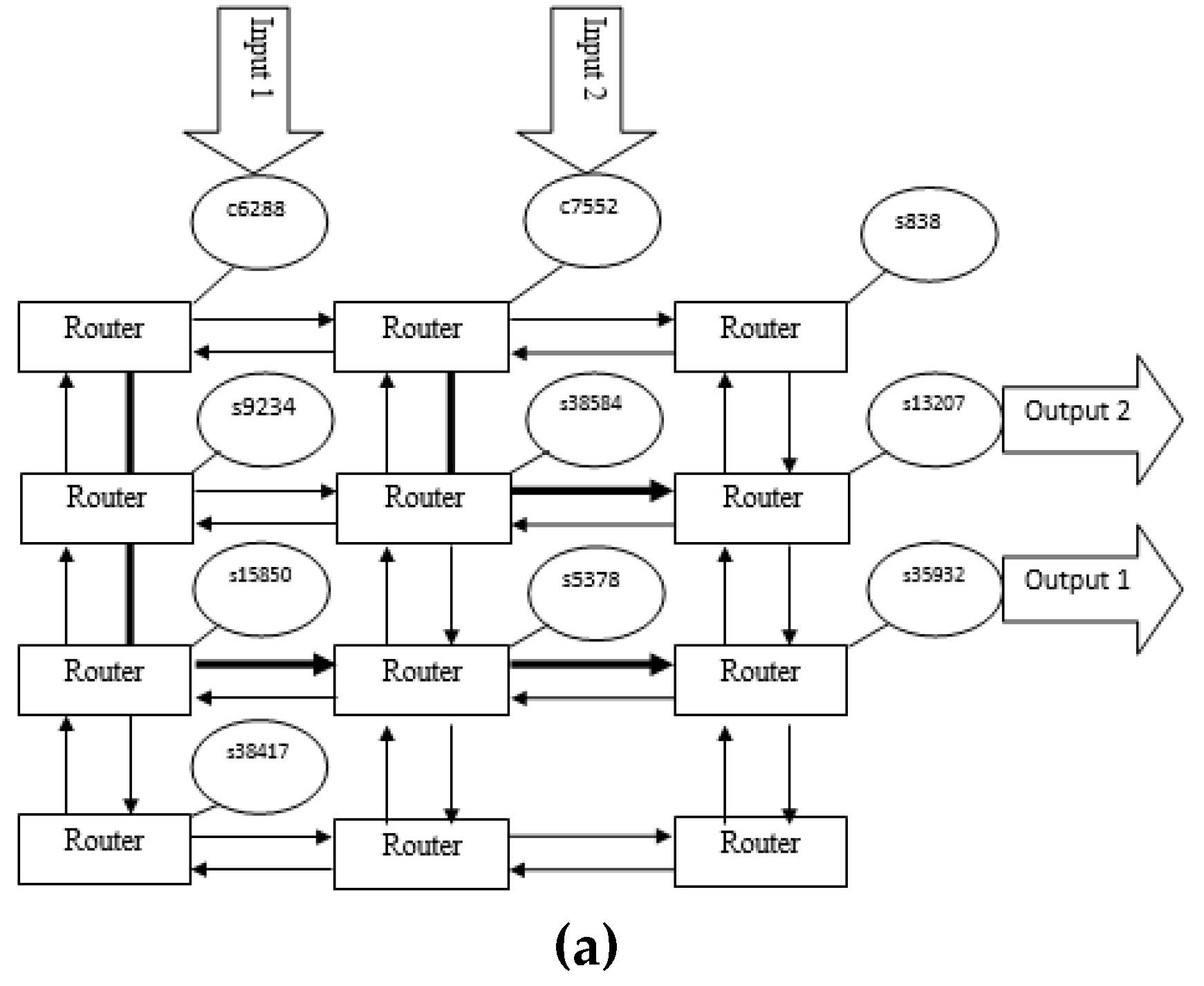
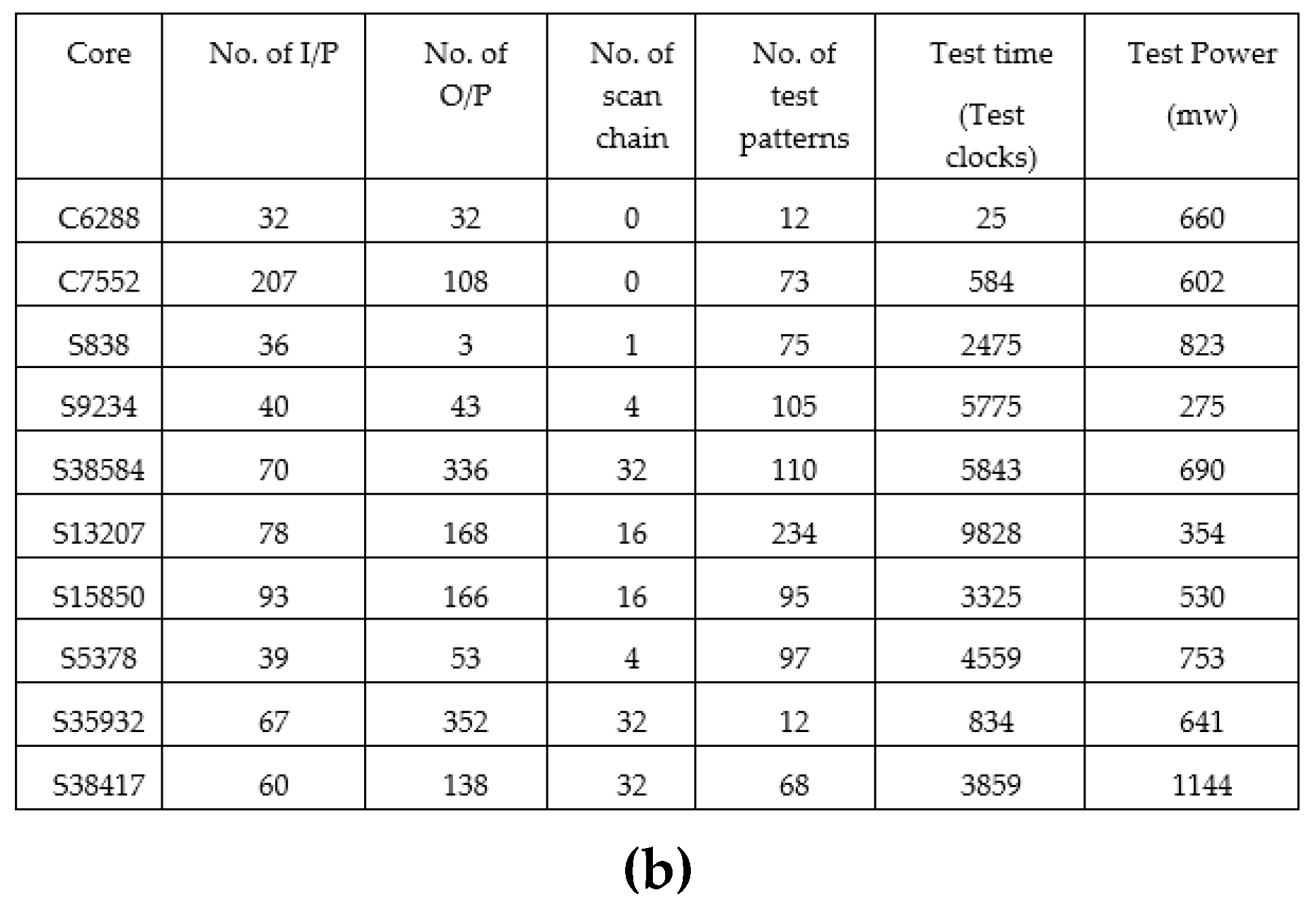
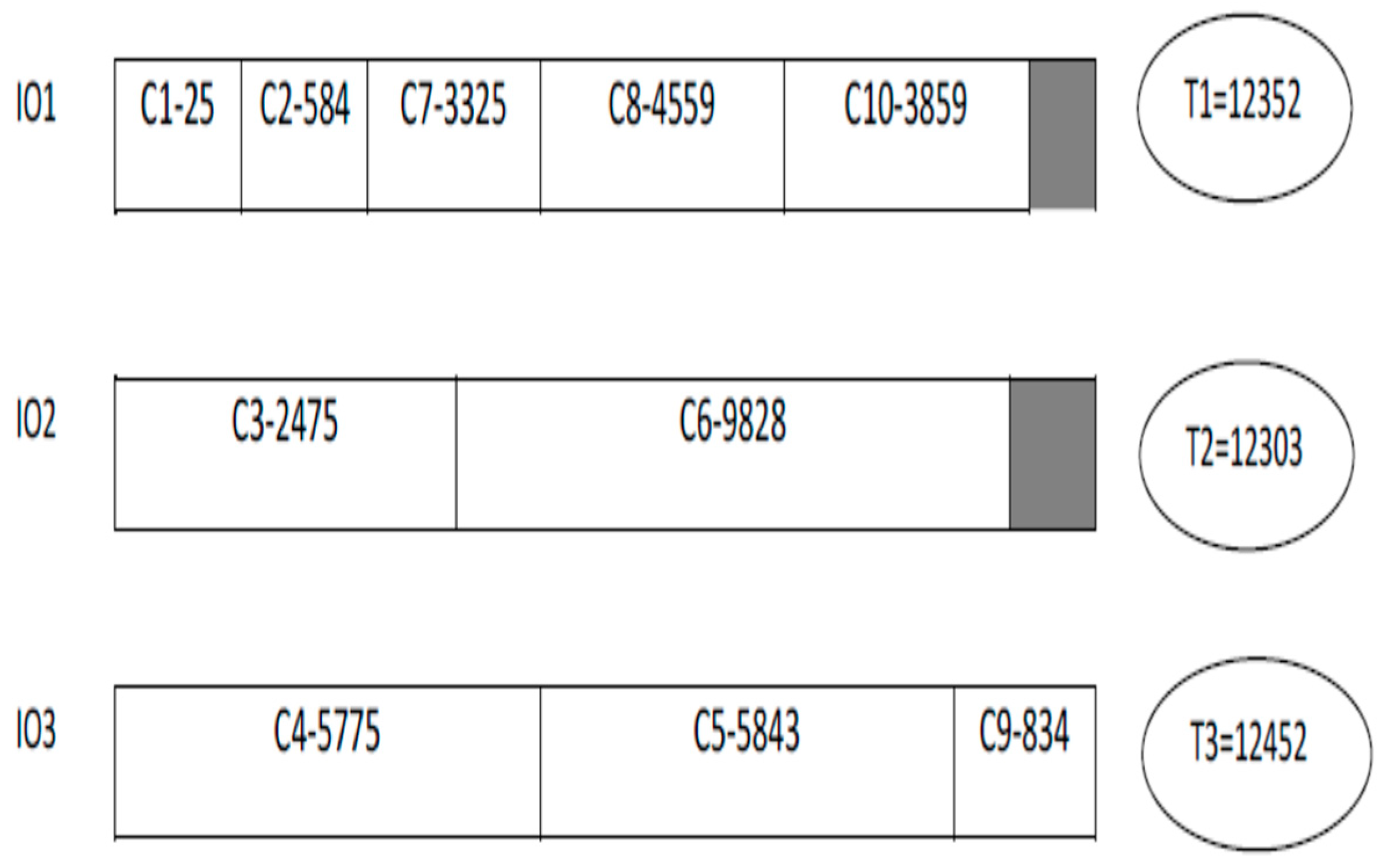
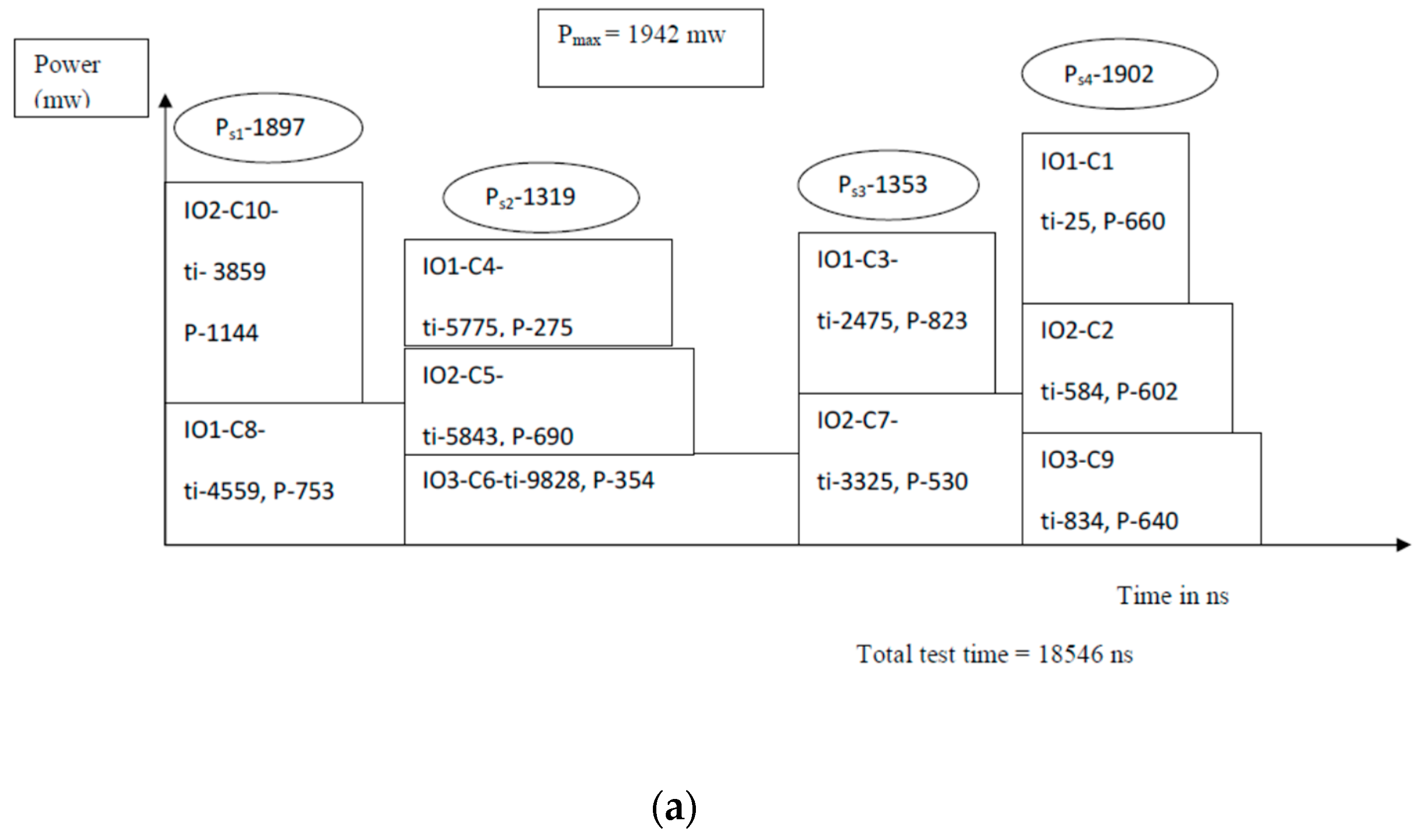
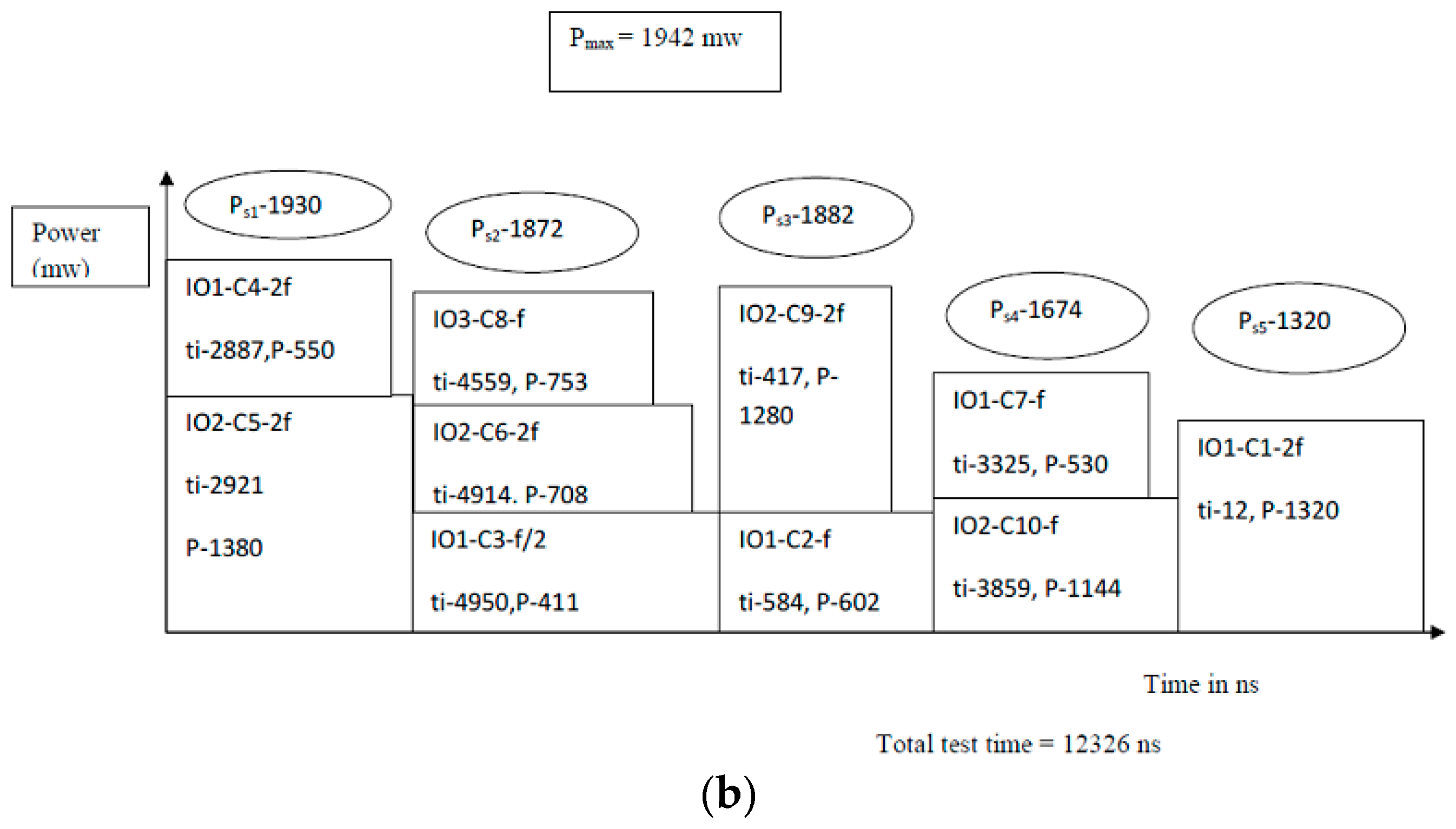
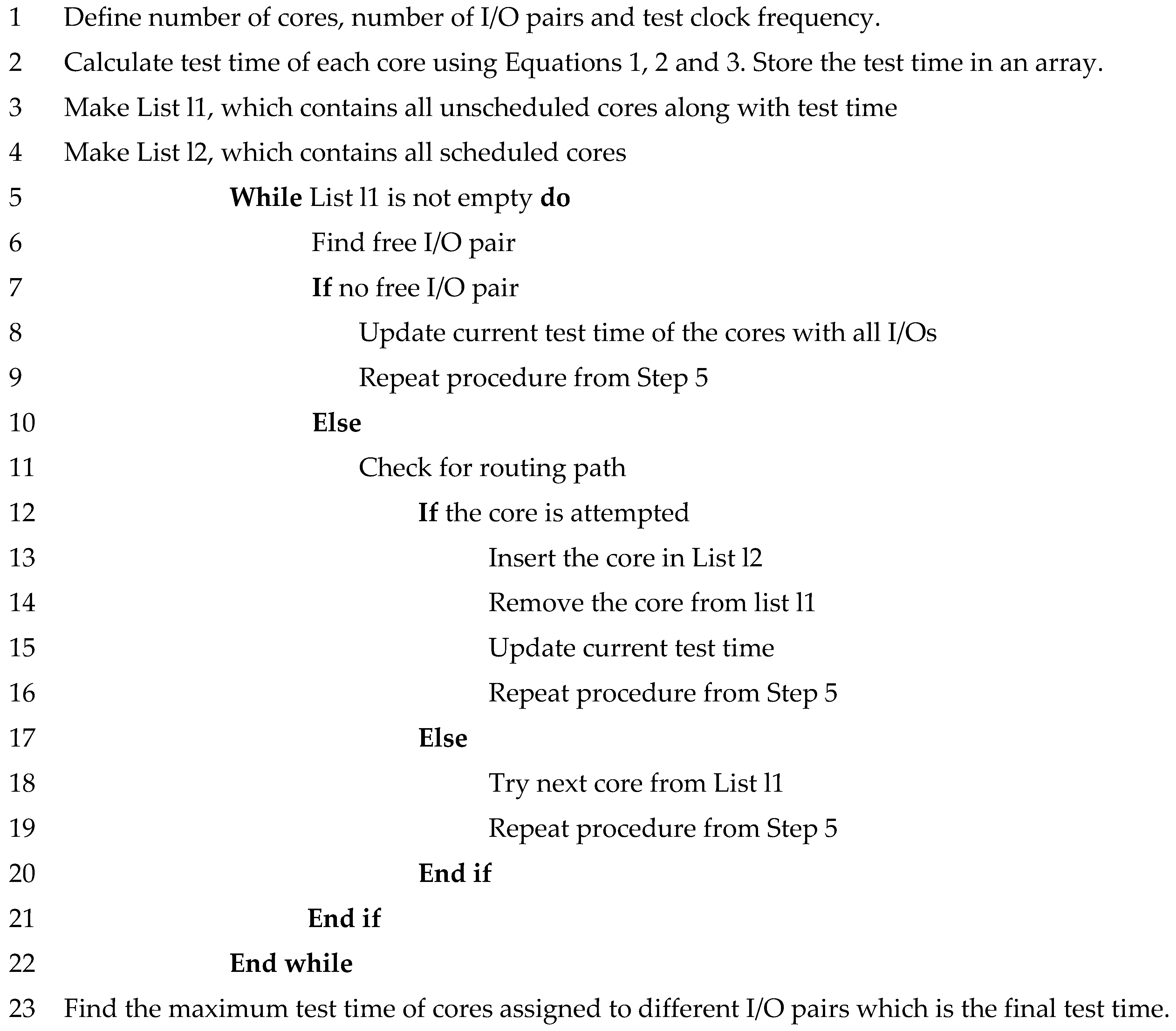
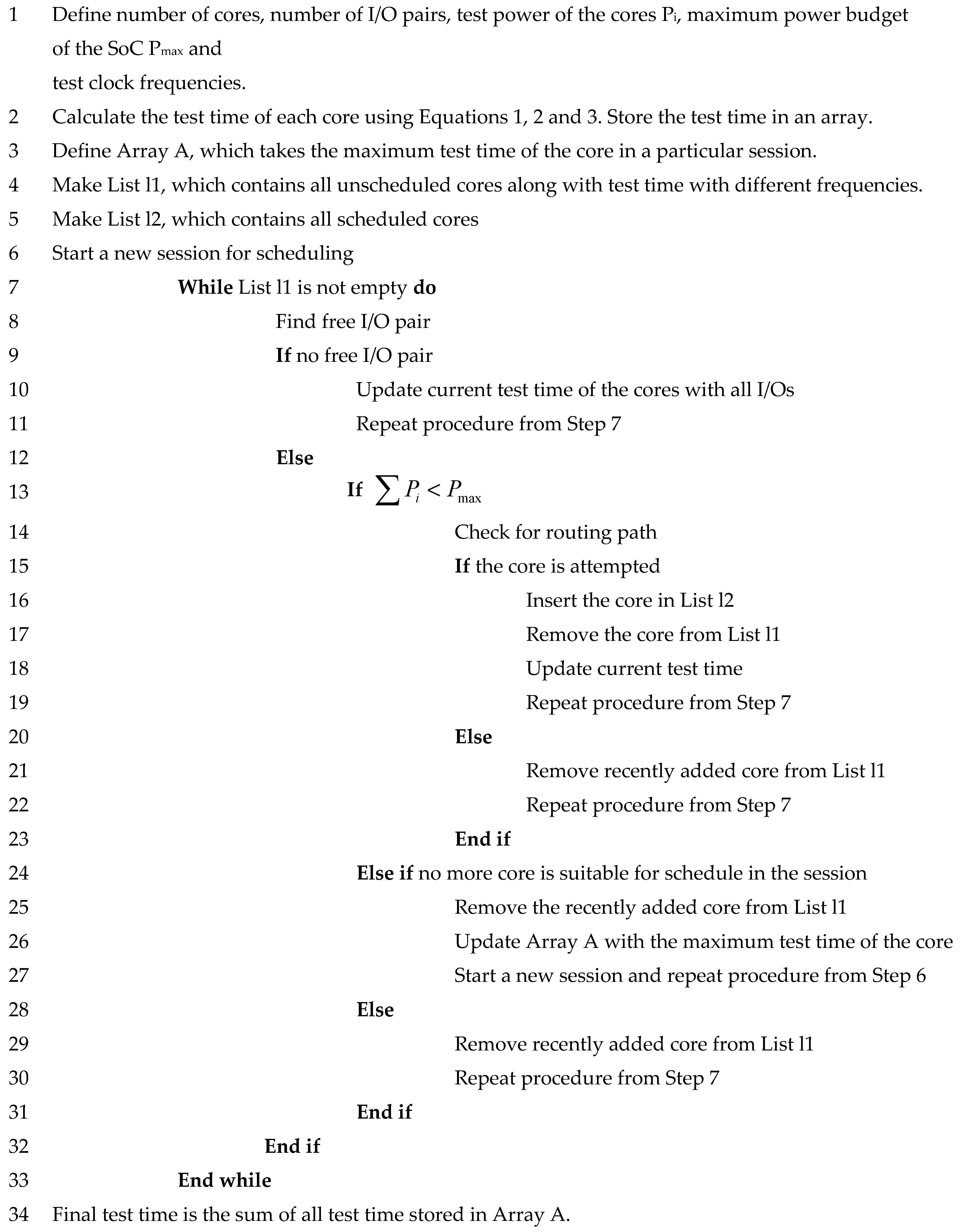
| Number of I/O Pairs | Test Time (nS) Required in Case of Single freq. Allocation [11] | Test Time (nS) Required in Case of Single freq. Allocation with Proposed ILP | Test Time (nS) Required in Case of Multiple freq. Allocation [11] | Test Time (nS) Required in Case of Multiple freq. Allocation with Proposed ILP |
|---|---|---|---|---|
| 2/2 | 18,869 | 18,561 | 14,176 | 9457 |
| 3/3 | 13,412 | 12,452 | 9073 | 6454 |
| 4/4 | 10,705 | 9828 | 9073 | 4914 |
| No. of I/O Pairs | Pair No. | A Sequence of Core Allocation with Corresponding Frequency Allocation to Particular I/O Pair | Test Time nS |
|---|---|---|---|
| 2/2 | 1 | Core3-2f, Core4-2f, Core6-2f, Core9-2f | 9457 |
| 2 | Core1-f/2, Core2-f, Core5-2f, Core7-2f, Core8-2f, Core10-2f | ||
| 3/3 | 1 | Core2-f, Core7-2f, Core8-2f, Core10-2f | 6454 |
| 2 | Core3-2f, Core6-2f, Core1-f/2 | ||
| 3 | Core4-2f, Core5-2f, Core9-2f | ||
| 4/4 | 1 | Core6-2f | 4914 |
| 2 | Core1-f/2, Core2-f, Core7-2f, Core8-2f | ||
| 3 | Core3-2f, Core4-2f, Core9-2f | ||
| 4 | Core5-2f, Core10-2f |
| No. of I/O Pairs | Test Time in ns [9] | Test Time in ns [Proposed] | % Reduction in Time as Compared to [9] | |||
|---|---|---|---|---|---|---|
| 50% of the Total Power Limit | 30% of the Total Power Limit | 50% of the Total Power Limit | 30% of the Total Power Limit | 50% of the Total Power Limit | 30% of the Total Power Limit | |
| 2/2 | 15,576 | 21,029 | 9167 | 12,881 | 41.4% | 38.7% |
| 3/3 | 12,887 | 18,317 | 8706 | 12,326 | 32.4% | 32.7% |
| 4/4 | 13,696 | 18,317 | 8706 | 12,326 | 36.4% | 32.7% |
| No. of I/O Pairs | Test Time in ns [9] | Test Time in ns [Proposed] | % Reduction in Time as Compared to [9] | |||
|---|---|---|---|---|---|---|
| 50% of the Total Power Limit | 30% of the Total Power Limit | 50% of the Total Power Limit | 30% of the Total Power Limit | 50% of the Total Power Limit | 30% of the Total Power Limit | |
| 2/2 | 177,915 | 211,505 | 152,671 | 153,111 | 14.4% | 27.6% |
| 3/3 | 154,478 | 199,151 | 106,560 | 107,926 | 31.0% | 45.8% |
| 4/4 | 143,044 | 195,122 | 76,546 | 95,718 | 46.4% | 50.9% |
| No. of I/O Pairs | Test Time in ns [9] | Test Time in ns [Proposed] | % Reduction in Time as Compared to [9] | |||
|---|---|---|---|---|---|---|
| 50% of the Total Power Limit | 30% of the Total Power Limit | 50% of the Total Power Limit | 30% of the Total Power Limit | 50% of the Total Power Limit | 30% of the Total Power Limit | |
| 2/2 | 498,353 | 538,062 | 338,902 | 417,432 | 31.9% | 22.41% |
| 3/3 | 436,400 | 523,082 | 279,212 | 354,218 | 36.0% | 32.2% |
| 4/4 | 387,841 | 512,280 | 275,207 | 353,913 | 29.0% | 30.9% |
© 2019 by the authors. Licensee MDPI, Basel, Switzerland. This article is an open access article distributed under the terms and conditions of the Creative Commons Attribution (CC BY) license (http://creativecommons.org/licenses/by/4.0/).
Share and Cite
Parmar, H.; Mehta, U. ILP Based Power-Aware Test Time Reduction Using On-Chip Clocking in NoC Based SoC. J. Low Power Electron. Appl. 2019, 9, 19. https://doi.org/10.3390/jlpea9020019
Parmar H, Mehta U. ILP Based Power-Aware Test Time Reduction Using On-Chip Clocking in NoC Based SoC. Journal of Low Power Electronics and Applications. 2019; 9(2):19. https://doi.org/10.3390/jlpea9020019
Chicago/Turabian StyleParmar, Harikrishna, and Usha Mehta. 2019. "ILP Based Power-Aware Test Time Reduction Using On-Chip Clocking in NoC Based SoC" Journal of Low Power Electronics and Applications 9, no. 2: 19. https://doi.org/10.3390/jlpea9020019
APA StyleParmar, H., & Mehta, U. (2019). ILP Based Power-Aware Test Time Reduction Using On-Chip Clocking in NoC Based SoC. Journal of Low Power Electronics and Applications, 9(2), 19. https://doi.org/10.3390/jlpea9020019





